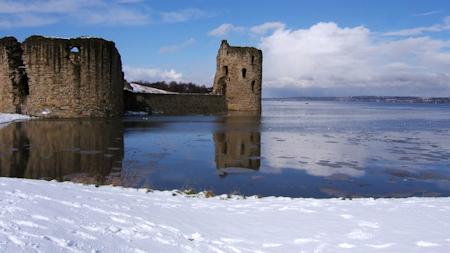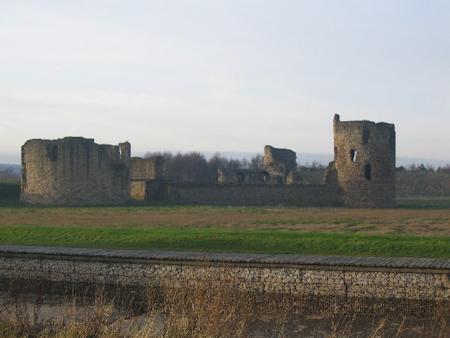
Flint Castle
Flint Castle has the distinction of being the first of King Edward I's ring of castles in North Wales. Although it is often overlooked in favour of its big sisters at Beaumaris, Caernarfon, Conway and Harlech, Flint is still an impressive structure with a layout that is unique in the British Isles.
The site of Flint Castle was carefully chosen for its strategic location. Only a day's march out of Chester, the castle sits on a low promontory that used to reach right into the estuary. The river used to fill the moat at high tide and there is evidence of a dock that could be used to resupply the castle during a siege.
Construction began in early 1277 under the direction of Richard L'Engenour. Thousands of men were employed digging ditches around the castle and constructing the new town.
The walls started to go up in 1279 and work was well underway when Master James of St George, Edward's master mason in Wales, took over the project in 1280. He stayed here until 1282 when the castle was largely complete and he was needed to oversee the work at Rhuddlan Castle.
Flint Castle Layout
The work on the castle finally finished in 1286, though it may never have reached its full height. By this point Edward had spent £6,068 building the fortress and town as well as over £700 building the ditches.
Flint was built in the medieval French (or Savoyard) style. The main keep is actually an enlarged corner tower set off to one side. The castle consists of a curtain wall enclosing an outer bailey with a second stronger wall surrounding the square inner bailey. A further line of defence is provided by the (now dry) moat on the southern gate side.
The inner curtain wall neatly skips around the keep and has three smaller mural towers at three of its corners. The inner wall is mostly gone now and has been replaced by retaining walls.
The best preserved of the three smaller towers is the North-East tower. It would originally have been four stories high. The rooms are polygonal and it was designed to provide accommodation.
The keep is placed off to one side of the inner bailey. It functioned as both a keep and a corner tower. It has a few unusual features. Unusually for an Edwardian castle there is no gatehouse. The gate was accessed via a drawbridge and the keep itself overlooks the gate and would have helped guard the outer bailey.
The entrance to the keep was at ground level and had an unusually long entrance passageway.
This design with this style of keep between the outer and inner walls was not repeated anywhere else in the UK, however it has been compared to some French castles, particularly Louis Xi's Tour de Constance at Aigues Mortes, which Edward would have seen before he went on Crusade.
Flint Under Assault
Flint was a target right from the outset. Before it was even fully constructed, it was under attack. Dafydd ap Gryffudd unsuccessfully assaulted the castle in 1282 and sacked the fledgling town.
In 1294 Madog ap Llywelyn attacked during his revolt. The castle was only saved when its constable set fire to parts of it prevent its capture.
Flint was the centre of English attention again in 1399. King Richard II of England had landed in Wales on July 24th after a military campaign in Ireland. He made his way across Wales to Flint where he was met by Henry of Bolingbroke's forces. Henry's was prepared to lay siege to the castle, but on August 19th Richard surrendered and was sent to the Tower of London. Henry seized the crown and became King Henry IV of England.
Flint also saw military action during the English Civil War. It was firmly on the Royalist side. It changed hands several times during the conflict and finally fell to Major-General Mytton after a three-month siege in 1646.
It didn't escape the slighting that befell so many castles after the war. On Cromwell's orders it was severely damaged. The ruins we see today are the result of this and subsequent removal of the stone for the nearby town.
Modern Day
Today Flint Castle is under the care of Cadw. It has been managed as a public monument for over 90 years. Access is freely available and most parts of the castle are open to the public. At the moment, however, access to the keep is restricted.
Flint also participates in the Doors Open Programme and on selected days you can be shown round by an expert guide. There is more information on the Wales Civic Trust website.
Status: Visitor Attraction / Historic Monument
Owner: Cadw
Tel: +44 (0)1443 336 000
Website: cadw.wales.gov.uk
Opening Times: Daily 10am to 4pm


Flint Castle and estuary in winter

North west towards Flint Castle's keep and tower